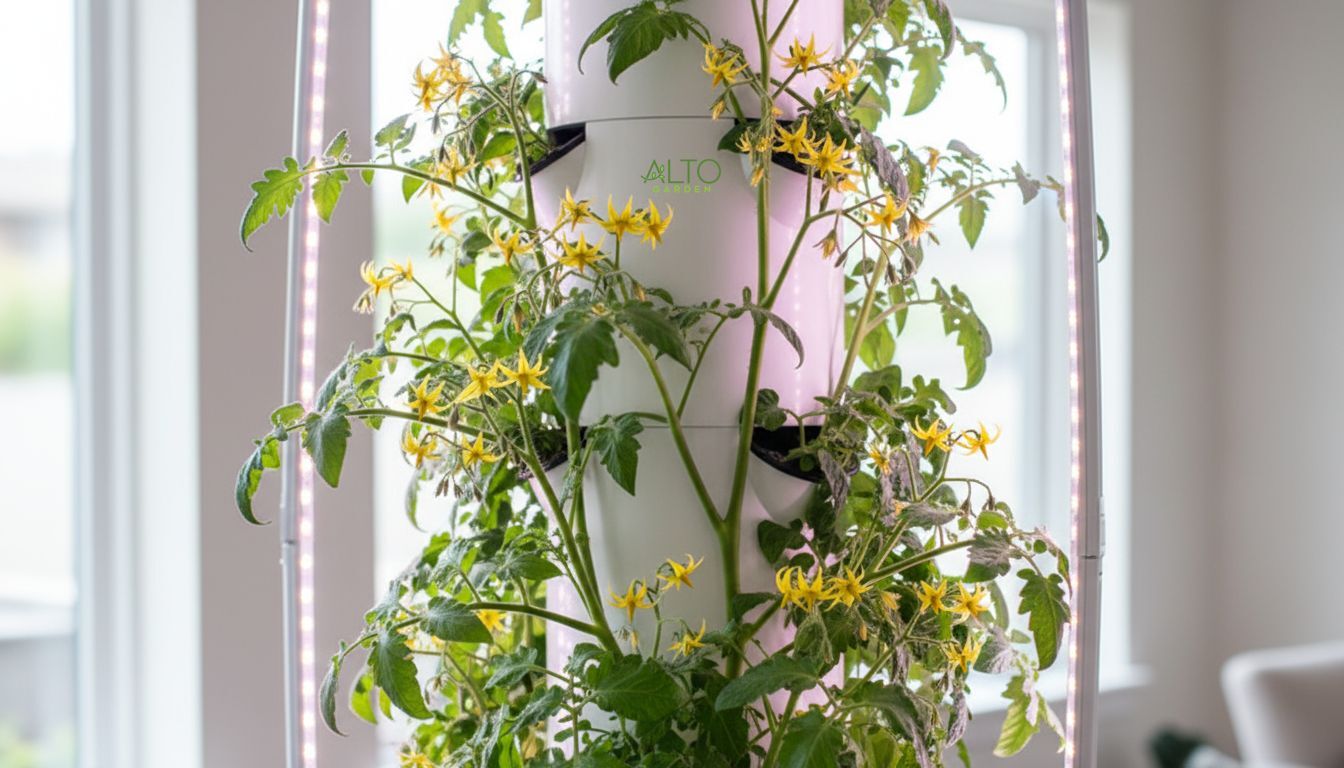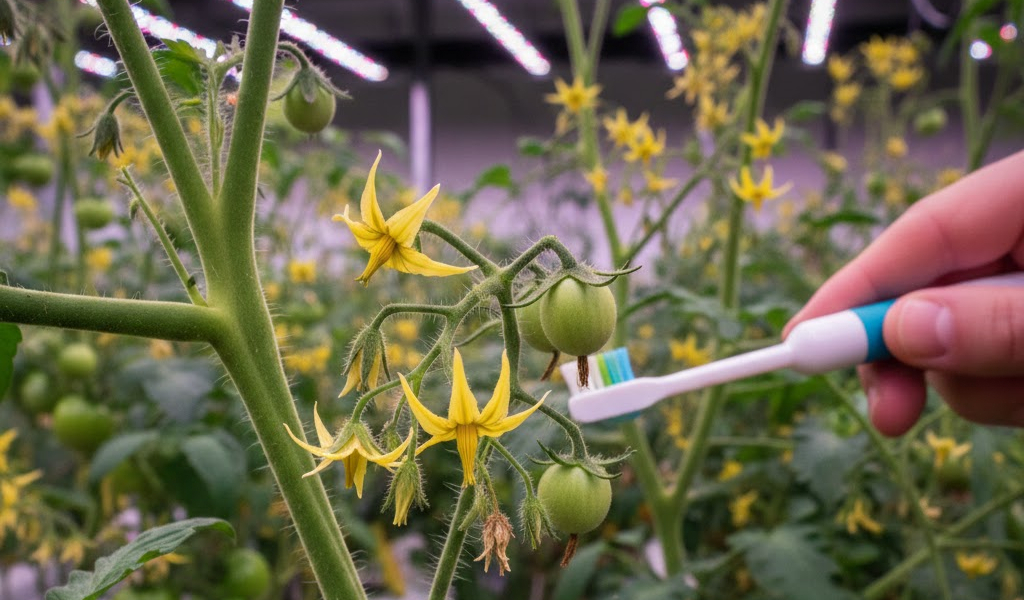Jul 8th 2024
Boosting Tomato Flowering: Best Practices for Indoor Gardens
Tomato pollination and flowering are vital for healthy, productive tomato plants. Knowing these processes can greatly improve your harvest, yielding higher yields and better-quality tomatoes.
Pollination is the process that allows flowers to develop into fruit. Without effective pollination, your tomato plants may produce fewer fruits or none at all. Maximizing tomato blooms directly correlates with higher yields. By ensuring that each flower is properly pollinated, you can boost the number of tomatoes your plants produce.
This post will cover the key aspects of tomato pollination needs, ways to boost flowering, and understanding the timing of blooms.

Do Tomatoes Need to Be Pollinated?
Tomatoes are typically self-pollinating, meaning each flower contains male and female parts, allowing them to pollinate themselves. However, cross-pollination can also occur where pollen from one flower fertilizes another. Wind and insects, which help transfer pollen between flowers, can facilitate this.
- Self-Pollinating: Most tomato varieties can pollinate themselves, so they don’t rely much on outside help.
- Cross-Pollinating: While not necessary, having different tomato plants pollinate each other can boost genetic diversity and improve fruit production.
Wind and Insects in Natural Pollination
In outdoor gardens, wind and insects play a significant role in pollination. The air movement shakes the plants, helping pollen fall from the male parts to the female parts within the same flower. Insects, especially bees, visit the flowers for nectar, inadvertently transferring pollen.
- Wind: It shakes the flowers, helping the pollen move around.
- Insects: Bees and other pollinators visit flowers, enhancing pollination through their activity.
Indoor vs. Outdoor Pollination Needs
Indoor tomatoes, including those grown in hydroponic or aeroponic systems, lack natural pollinators like wind and insects. They often require manual assistance to ensure proper pollination. Without this intervention, indoor plants may not produce as many fruits.
Pollination Methods
As we said before, outdoor gardens benefit from natural elements like wind and insects that facilitate pollination. These natural forces help move pollen from the male to the female parts of the flowers, ensuring fruit development.
In indoor or controlled environments, manual pollination becomes essential. Here are some techniques for hand-pollinating tomatoes:
- Electric Toothbrushes: Gently vibrating the flowers with an electric toothbrush helps release the pollen.
- Paintbrushes: Lightly brushing the inside of the flowers can transfer pollen effectively.
- Shaking the Plant: Gently shaking the plant or its branches can mimic the effects of wind.

Pollination in Hydroponic/Aeroponic Systems
One of the main challenges of growing tomatoes indoors is the lack of natural pollinators. Without wind or insects, indoor tomato plants may struggle to pollinate themselves, reducing fruit sets.
Manual pollination is crucial for indoor tomatoes to overcome the absence of natural pollinators. Regularly assisting your plants with pollination can significantly improve their productivity.
- Regularly Check for Flowers: Keep an eye on your plants and give them a little help with pollination when you see flowers.
- Use Fans: Mimicking wind with fans can help distribute pollen and encourage pollination.
- Manual Tools: Tools like electric toothbrushes or paintbrushes can be convenient for helping with pollination.
By mastering and applying these techniques, you'll guarantee your indoor tomato plants are well-pollinated, resulting in a superior yield and top-notch fruit quality. Consistent care for your plants' pollination requirements will reap rewards with a plentiful harvest.
How to Increase Flowering in Tomatoes
To maximize the flowering and fruiting of your tomato plants, focus on several key factors: light, temperature, nutrients, and pruning. Each element is crucial in ensuring your plants produce as many blooms as possible.
Light and Temperature
Providing your tomato plants with the right amount of light is critical. Tomatoes need 12-16 hours of light per day to thrive and flower profusely. Investing in quality grow lights can make all the difference if you're growing tomatoes indoors.
- LED Grow Lights: These lights are fantastic because they’re energy-efficient, last a long time, and provide all the light wavelengths your tomatoes need for photosynthesis. They’re an excellent investment for serious indoor gardeners.
- Fluorescent Lights: These are a more budget-friendly option. They still do a good job, but you might need to replace them more often than LEDs. T5 fluorescent lights are particularly effective for growing plants.
Maintaining the ideal temperature is vital for tomato flowering. Tomatoes flourish best at temperatures between 70-85°F. Managing temperature fluctuations in hydroponic or aeroponic systems can be more straightforward with the right equipment.
- Heaters and Coolers: To keep your tomato plants happy, use heaters to warm things up and coolers to bring the temperature down. This helps maintain a steady environment, which tomatoes love.
- Thermostats and Timers: These gadgets can automate your temperature control, ensuring your plants stay within the perfect range. Just set it up and let the technology do the work for you.
Nutrient Management
Balanced nutrient solutions are crucial for the flowering phase of tomato plants. Ensuring your plants get the proper nutrients will encourage more blooms.
- Phosphorus: This nutrient is crucial for developing strong roots and beautiful flowers. It’s a key player in your tomatoes’ growth.
- Potassium: Think of potassium as an overall health booster for your plants. It’s essential for good flower formation and helps your plants thrive.
Following a recommended nutrient schedule is vital to ensuring your tomatoes get what they need when they need it.
- Early Growth: During this phase, your tomato plants need more nitrogen to help them grow lots of healthy leaves and stems.
- Flowering Phase: When your plants start to flower, it’s time to up the phosphorus and potassium. This supports the development of blooms and future fruits.
Pruning and Plant Care
Pruning your tomato plants correctly can significantly boost flowering. Here’s how to do it:
- Remove Suckers: Suckers are those little shoots that grow between the main stem and the branches. By removing them, you help your plant focus its energy on producing flowers and fruits instead of extra foliage.
- Trim Dead Leaves: Reducing yellow or dead leaves improves airflow around your plant and ensures more light reaches the healthy parts. This keeps your plant healthier and encourages more flowers.
Managing stress is crucial for encouraging tomato plants to flower.
- Avoid Overwatering: Too much water can cause root rot and other problems. Make sure your plants are well-drained to keep them healthy.
- Use Stressors Strategically: A little stress, like strategic pruning, can actually stimulate your tomato plants to flower more. Just be careful not to overdo it, as too much stress can harm your plants.
Focusing on these factors—light, temperature, nutrients, and pruning—can effectively increase the flowering of your tomato plants, leading to higher yields and a more bountiful harvest. Ensuring optimal conditions and proper care will result in healthier plants and more delicious tomatoes.

When Do Tomatoes Bloom?
Knowing when tomatoes are likely to bloom helps you plan your gardening activities and maximize your harvest. Typically, tomato plants follow a predictable timeline from planting to blooming, but several factors can influence this timing, including the variety of tomatoes, growing conditions, and the care they receive.
Bloom Stages
Understanding the stages of tomato growth, from germination to flowering helps in identifying the proper care at each phase.
- Germination: Seeds sprout and develop into seedlings within the first 5-10 days. Keep the soil moist but not waterlogged, and provide plenty of light.
- Vegetative Growth: Over the next 4-6 weeks, plants develop a robust structure with leaves and stems. Ensure your plants get 12-16 hours of light daily and maintain consistent temperatures around 70-85°F. Regularly feed them with a balanced nutrient solution.
- Flowering: Typically begins around 6-8 weeks after planting, signaling the start of fruit production. Increase phosphorus and potassium in your nutrient mix to support blooming.
Knowing when your tomato plants are ready to bloom helps you provide the best care. Here’s what to look for:
- Signs of Bloom Readiness: Look for the formation of flower buds at the junction of the stem and leaves. These tiny buds are your signal that flowering is about to start.
- Standard Bloom Times: Early varieties may start blooming within 50 days, while larger, indeterminate varieties might take 70-85 days.
Several factors can influence when your tomato plants start to bloom:
- Variety: Different tomato varieties have their own growth rates and bloom times. Be sure to know what type you’re growing.
- Growing Conditions: Light, temperature, and humidity levels can speed up or slow down blooming.
- Care: Proper pruning, watering, and nutrient management are crucial for timely flowering.
Upgrade to Smarter Indoor Growing
Enjoy higher yields, automatic watering, and year-round harvests with our space-saving hydroponic tower.
Order Your TowerOptimizing Bloom Conditions
Keeping your tomato plants happy and blooming is all about maintaining consistent care. Here’s how to make sure your plants thrive:
- Light: Ensure your plants receive 12-16 hours of light daily, using grow lights if necessary.
- Temperature: Keep the temperature between 70-85°F for optimal flowering.
- Nutrients: Provide a balanced nutrient solution, increasing phosphorus and potassium during the flowering stage.
Regularly checking your plants and adjusting their care helps maintain optimal blooming conditions.
- Tools for Monitoring: Use thermometers, hygrometers, and light meters to keep track of environmental conditions.
- Adjustments: Be ready to tweak light intensity, temperature settings, and nutrient concentrations based on plant needs.
Conclusion
Growing tomatoes successfully means understanding their pollination needs, flowering processes, and the best conditions for blooming. Knowing how to pollinate your plants, either naturally or manually, ensures they produce more fruit. Key factors like light, temperature, nutrients, and pruning can significantly boost flowering and yield.
Keep an eye on your plants and adjust care as needed to create the perfect growing environment. Whether you’re gardening in soil or using hydroponics, consistent care is essential. With these strategies, you’ll enjoy a bountiful harvest of delicious, home-grown tomatoes.
Every step you take to meet your tomato plants’ needs brings you closer to a successful and rewarding gardening experience!
FAQs
- Why are my indoor tomato plants not producing fruit?
Indoor tomatoes often have trouble because they don't have natural pollinators. Without wind or insects, flowers may not fully pollinate so manual pollination may be necessary. - What kind of light is best for indoor tomato flowering?
LED grow lights are the most effective because they provide strong, full-spectrum light and support consistent flowering. Fluorescent lights work too, especially for smaller spaces. - Can I grow tomatoes indoors without growing lights?
It’s possible near a very bright south-facing window, but grow lights are recommended because tomatoes need 12–16 hours of strong, consistent light. - Why are my indoor tomato flowers dropping?
Flower drop can happen due to low light, high heat, poor airflow, or incorrect nutrients. Ensuring proper indoor conditions usually fixes the issue. - Do tomato plants flower differently when growing tomatoes indoors?
Yes, indoor plants often need controlled light, temperature, and airflow. They may also need manual pollination because natural pollinators like bees and wind are not present.




